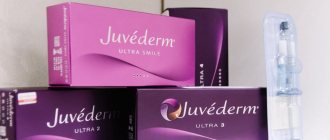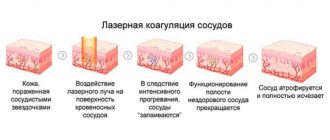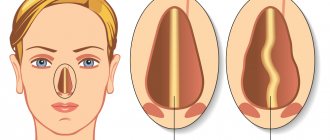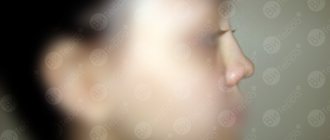A deviated nasal septum can be a consequence of injury or a congenital problem. It occurs in a large number of people and is perceived as commonplace; many do not even think that the problem can lead to serious problems in the body. Vladimir Zaitsev, Ph.D., otolaryngologist of the highest category, told AiF.ru what exactly the risks are, as well as when it is necessary to correct the septum through surgery
“If everything is normal with the septum, the person breathes freely and does not experience any discomfort. But as soon as a curvature appears, life is disrupted,” says Vladimir Zaitsev. A deviated septum, as the specialist notes, is an individual thing, but in any case, the defect leads to a number of serious health problems.
Chronic rhinitis
As Vladimir Zaitsev notes, a deviated septum causes constant runny noses. The mechanism of their formation is simple. “A deviated septum provokes tissue growth around it. After all, the septum itself only divides the nasal cavity in half. Against the background of its curvature, an increase in the inferior nasal concha is provoked, as a result of which the person begins to breathe worse,” explains the doctor.
An otorhinolaryngologist identifies three types of rhinitis that can develop:
· vasomotor;
· hypertrophic;
· subatrophic, when dryness and burning in the nose are observed.
Pollen or infection? What diseases are often mistaken for allergies Read more
How to prepare for surgery?
Before scheduling, you should meet with your surgeon to discuss the risks and expectations of this procedure. A specialist appointment usually includes:
- Medical history. During the conversation, the doctor asks questions about your condition, any complaints you currently have or had previously, how your symptoms have changed over a certain period of time, what medications you have used before or are currently using.
- Instrumental examination. The doctor conducts an instrumental examination of ENT organs, examines the skin, and palpates regional lymph nodes. Performs an endoscopic examination - this is an examination of the nasal cavity using modern video technology and visualization of the picture on the monitor.
- CT scan. According to all modern international standards, for the diagnosis of diseases of the nasal cavity, including the diagnosis of a deviated nasal septum, it is necessary to perform a CT scan of the nasal cavity.
- The discussion of the results. The doctor explains the features of the operation, what septoplasty can or cannot correct, what sensations will occur in the first hours and days after the operation, how quickly free nasal breathing will occur, i.e. What can a patient expect after treatment to correct a septum?
Taking medications
Before and after surgery to correct the nasal septum, avoid taking medications with acetylsalicylic acid (aspirin). These medications may increase bleeding. Take only medications that are approved or prescribed by your surgeon.
Other Precautions
In the postoperative period, for 10-15 days, patients must avoid physical activity, visit the pool, bathhouse, sauna, and avoid flights.
If you smoke, it is better to quit this habit; it disrupts the healing process after surgery.
Risks of nasal septum correction
As with any surgery, septoplasty also carries possible risks, such as bleeding, infection, or a reaction to the anesthesia. To avoid complications, a thorough preoperative examination and strict adherence to the specialist’s instructions after surgery are necessary.
Loss of smell
By the way, a common disorder today—loss of smell—can also be a consequence of a deviated septum. “There are two zones in the nose: respiratory and olfactory. If the nose breathes poorly (and it breathes poorly against the background of a deviated septum), there can be no talk of any good sense of smell, since the mucous membrane swells and becomes inflamed,” says Vladimir Zaitsev. At the same time, as ENT notes, the problem lies deeper than it might seem at first glance. After all, the sense of smell, together with other senses, forms the worldview; without it, people cannot feel all the colors and fullness of the world. A person may also experience taste inversion when he perceives food incorrectly.
Why is septoplasty performed?
Having a deformed nasal septum is common.
However, when a severely deviated septum becomes a serious problem, it can block one side of the nose and reduce air flow, causing difficulty breathing. In the future, this often leads to atrophy of the mucous membrane and pathologies with the paranasal sinuses - bleeding, sinusitis and other forms of sinusitis. This operation to correct the septum or endoscopic septoplasty is performed by changing the shape and position of curved areas of bone and cartilage through a small incision (4-5 mm) in the nasal cavity.
If you experience symptoms such as: difficulty breathing through the nose, nasal congestion and discharge, frequent sinusitis, snoring in your sleep - all this indicates a deviated nasal septum.
Sign up for a consultation
Hearing loss
A deviated septum also causes hearing loss. “Against the background of its curvature, inflammation is formed, which passes into the nasopharynx, where the auditory tube opens. There is a feeling of deafness, stuffiness in the ear, and otitis media becomes more frequent,” says Vladimir Zaitsev.
Complication: meningitis. How to recognize sphenoiditis and quickly cure it? More details
Indications for septoplasty:
- constant nasal congestion, regardless of the time of year
- frequently recurring acute sinusitis (4-6 times a year)
- chronic sinusitis that cannot be treated for a long time
- frequent nosebleeds associated with a deviated nasal septum
- the occurrence and frequent exacerbations of chronic purulent otitis media with the presence of perforation of the tympanic membrane
After all the examinations performed, the appropriate volume of surgery is selected (septoplasty, vasotomy, conchopexy, etc.). The doctor will tell the patient in detail about the course of the operation, the postoperative period and answer all questions. Our goal is to minimize the risk of complications and speed up the patient’s recovery period.
Down with peaceful sleep
A defective septum causes the development of night snoring. And this is a problem for both health and family relationships. “The brain does not receive oxygen, there is no proper breathing at night. The brain is not ventilated, the person wakes up broken. Against this background, performance also deteriorates, since by the time the sleep-deprived person leaves, lunch has already arrived,” says Vladimir Zaitsev.
Family life also suffers, since in unfavorable living conditions it is very difficult for family members to coexist with a snorer. “And nighttime snoring, which occurs against the background of a deviated septum, is life-threatening, as it causes heart attacks and, to a greater extent, strokes,” emphasizes the ENT specialist.
Article on the topic
Breath of the desert. What are the dangers of chronic nasal dryness?
We care about your health
According to statistics, 25% of the world's population has a deviated nasal septum. Half of them experience problems with nasal breathing and require surgery for medical reasons. At the Medkvadrat clinic, the operation is performed by competent specialists with more than 25 years of experience. Septoplasty is performed under general anesthesia using modern ENT surgery methods.
The nasal septum divides the nasal cavity into 2 parts. It consists of bone and cartilage tissue. When deformed, the septum moves to the left or right of the midline.
This condition causes a person many inconveniences:
- breathing through the nose becomes difficult, becomes heavy and uneven;
- severe snoring appears;
- at times blood flows from the nose;
- the shape of the nose changes.
It has been proven that a deviated septum leads to the development of chronic ENT diseases: tonsillitis, rhinitis, sinusitis, frontal sinusitis and others.
Why do deviated nasal septums occur?
The most common reasons are:
- Physiological features.
As our bodies develop, the bone and cartilage portions of the nasal septum may grow unevenly. As a result, it is completely deformed and shifted to one side. Or projections form on its surface, which are called ridges and spines.
- Injuries.
A deviated nasal septum occurs as a result of a bruise, blow or fall. Most often, the deformity occurs in athletes. Even minor damage to the nose can have serious consequences.
- Compensatory mechanisms.
The deformity develops in response to the presence of foreign bodies (piercings), polyps and adenoids in the nasal cavity, or as a consequence of vasomotor rhinitis.
Septoplasty surgery helps correct a deformed nasal septum and get rid of its consequences . Surgical treatment is indicated in the following cases:
- Correction of a cosmetic defect.
- Heavy snoring.
- Difficulty in nasal breathing.
- Frequent diseases of the ENT organs.
During the intervention, the doctor corrects the bone and cartilage tissue of the nasal septum and returns it to its normal position if it is “tipped” to the side.
What examination should be done before septoplasty?
Before the operation, the patient consults with the attending ENT doctor. After examining the nasal septum using an endoscope and rhinoscope, the specialist determines the method and extent of the intervention and the method of pain relief.
The ENT doctor also prescribes an examination that must be completed before septoplasty.
Typically, preoperative preparation includes:
- plain radiography;
- laboratory tests: general blood test, general urinalysis, blood biochemistry;
- electrocardiography;
- consultation with a therapist;
- consultation with an anesthesiologist.
How to properly prepare for septoplasty?
A month before surgery, it is advisable to give up bad habits: smoking and drinking alcoholic beverages. The doctor may also prescribe a diet limiting sweets, flour, confectionery and fatty meats.
The patient comes to the operation on an empty stomach: the dinner on the eve of the procedure should be light and no later than 12 hours before the intervention.
If you are taking medications, consult your doctor. Some medications may need to be stopped for a while. For example, products with acetylsalicylic acid and non-steroidal anti-inflammatory drugs.
How is septoplasty performed?
The intervention is carried out in 4 stages.
- Introduction to anesthesia.
The method of anesthesia is determined by specialists: an anesthesiologist and an ENT doctor. As a rule, general anesthesia is used: mask and intravenous. Additionally, the doctor uses local anesthetics, which are injected subcutaneously (infiltration anesthesia) to reduce bleeding. As soon as the anesthesia takes effect, the doctor begins the operation.
- Surgical intervention.
To get to the nasal septum, the doctor makes an incision in the mucous membrane at the border with the skin. Using surgical instruments, he peels off the mucous membrane and removes deformed parts of bones, spines and ridges that protrude into the nasal cavity and make breathing difficult. The doctor does not remove the cartilage tissue, he only models it using tools. After some time, the cartilage itself takes on a median position.
During the operation, the integrity of the septum is maintained.
In addition to classical intervention, modern methods of restoring the nasal septum, including endoscopic, are performed.
Endoscopic septoplasty
A thin and flexible probe, an endoscope, with a mini camera at the end is inserted into the nasal cavity through the nostrils. The doctor sees the nasal septum close-up on the monitor. Visual control allows the doctor to accurately perform all manipulations. It does not miss curved areas and is less likely to injure soft tissues and blood vessels.
- Applying internal sutures.
After correcting the nasal septum, the doctor returns the soft and dense tissues to their place and stitches them together. Our specialists apply self-absorbing sutures to the incisions on the mucous membrane. There is no need to delete them.
- The final stage.
The doctor inserts tampons or special silicone tubes into the nasal passages. He places a fixing bandage on top of the nose.
Recovery
For 1-2 days after the operation, the patient remains in the hospital under the supervision of a specialist.
To prevent the nasal mucosa from drying out, the doctor prescribes special ointments and rinses with saline solution. Nurses will help you rinse and lubricate your nose.
Respiratory function is restored gradually over 1-2 weeks. After surgery, you need to blow your nose carefully so as not to cause bleeding.
The first month after the procedure, physical activity is excluded. It is not recommended to visit the sauna, bathhouse and swimming pool.
Questions and answers about septoplasty.
What contraindications to surgery exist?
Contraindications for surgery are determined by the doctor. Surgical intervention is not performed for severe diseases of the endocrine and cardiovascular systems, liver, and autoimmune disorders.
At what age can septoplasty be performed?
From 16-18 years old. At this age, the growth of bone and cartilage tissue ends. For children from 11 and even from 6 years of age, surgery is performed if there is severe curvature and serious problems with nasal breathing.
How long does the operation take?
Septoplasty usually lasts 40-60 minutes.
What is a cristotomy?
This is a type of septoplasty . Cristotomy surgery involves removing the ridge on the nasal septum. The ridge is the protruding part of the septum, consisting of bone or cartilage and bone. It usually forms after a nasal injury.
What operations are performed along with correction of the nasal septum?
In our center, simultaneously with septoplasty, we perform:
Vasotomy is the destruction of the blood vessels of the nasal concha to combat swelling. Indicated for patients with vasomotor rhinitis.
Conchotomy is partial or complete removal of enlarged nasal turbinates.
Sinusotomy - opening the nasal sinus and removing pathological contents.
Rhinoplasty is an aesthetic correction of the shape of the nose.
The possibility and feasibility of simultaneous septoplasty and these operations is determined by the doctor. When making a decision, he proceeds from the individual characteristics of the patient and the degree of curvature of the nasal septum.
How much does the operation cost?
| Operation | Price |
| septoplasty | 44500 rubles |
| nasal cristotomy | 23500 rubles |
| septoplasty with correction of intranasal structures | 63,000 rubles |
| reconstructive-functional septorhinoplasty | 100,000 rubles |
Why should you trust Medkvadrat specialists?
Operating ENT doctors with extensive practical experience.
In our center, septoplasty is performed by a doctor with more than 25 years of experience:
Rakhimov Rashid Tulkunovich – otolaryngologist. Head of the ENT department at Medkvadrat. Highly qualified doctor, candidate of medical sciences. Performs all types of ENT operations: vasotomy, septoplasty , rhinoseptoplasty, rhinoplasty, adenoid removal, tonsillectomy, sinusotomy.
Extensive experience allows a specialist to correctly determine the type of curvature and select the optimal method of surgical treatment for adults and children.
Modern methods of surgical treatment.
Our specialists perform septoplasty using modern surgical and endoscopic equipment. Surgeries are performed in new sterile operating rooms.
Septoplasty is performed under general anesthesia: intravenous and mask.
A clinic with an excellent reputation.
For 10 years now we have been taking care of the health of our patients, many of them have become regular clients of our clinic. Every year, the center treats more than 25 thousand patients and performs more than 700 operations.
If you want to get rid of breathing problems, snoring and chronic diseases of the ENT organs, sign up for a consultation with our specialists right now.
To fix or not?
Of course, the question arises: is it necessary to correct the septum if it is not critically curved? Here, as Vladimir Zaitsev says, you need to work closely with the doctor. Only a specialist, based on examination, will be able to determine the degree of damage and the threat to health and life. If the doctor suggests surgery, you should agree. If you have doubts, you can have another consultation in another place and get a solution there. You can also go through a procedure to measure your breath. A person breathes into a special apparatus, after which doctors analyze the data from it: how many liters of air have passed, how it has passed, etc. There are certain standards according to which the quality of breathing can be determined.
“Today there are several options for operations, as well as techniques. You can use both the full version and the gentle one. It all depends on the position of the partition,” says Vladimir Zaitsev.
During surgery
Surgery to correct the nasal septum - endoscopic septoplasty can be performed either under local anesthesia or general anesthesia, depending on the preferences of the patient and the surgeon, as well as the complexity of the operation.
- Local anesthesia. This is a method of pain relief limited only to the nasal cavity. The doctor injects a pain-relieving medicine (anesthetic) into the tissues of the nasal cavity. Also, in addition to local anesthesia, it is possible to use sedation, which is performed using drugs administered intravenously. This method does not completely turn off the patient’s consciousness.
- General anesthesia (anesthesia). During general anesthesia, painkillers and sleep-inducing drugs are administered intravenously or by inhalation. As a result, the patient is in a state of deep sleep throughout the operation.
Be sure to discuss with your doctor which type of anesthesia is best for your case.
At the end of the operation, a small incision inside the nasal cavity is closed with an absorbable suture. If necessary, silicone splints are installed in both halves of the nasal cavity to support the septum for 3-4 days.
After surgery to correct the nasal septum, you move to a ward where staff monitors you throughout the day.
Modern septoplasty technique:
In our clinic, a modern technique of septoplasty , which consists of the following: an incision is made inside the nose and the scar is subsequently not visible. The cartilaginous section of the nasal septum is separated from the mucous membrane and perichondrium on only one side, after which the cartilage is separated from the bony section and shifted to the side. After this, bone ridges and spines are identified and removed in the posterior parts of the nose, creating free space for cartilage. The curved cartilage of the nasal septum is not removed, but is modeled in a certain way and returned to its place. Subsequently, due to its biomechanical properties, it takes on a median physiological position. In this way, the nasal septum maintains its supporting function by preserving cartilage . The use of modern surgical techniques minimizes the risk of developing perforations of the nasal septum and postoperative deformation of the nose.
Surgeries on the nasal septum are performed under general anesthesia. The patient is under anesthesia and does not experience any discomfort or pain. The final awakening after the end of the operation occurs in the ward.
The duration of basic ENT operations on the nasal septum is about 1-2 hours. At the end of the operation, the doctor installs soft elastic tampons with air tubes . These tampons hold the sheets of mucous membrane and prevent blood from accumulating between them, and the airway tubes allow the patient to breathe through the nose even with tampons in it. Tampons are removed from the nasal passages 48 hours after surgery.
How is surgery performed on the tip of the nose?
If a patient turns to a plastic surgeon with a problem such as a wide tip of the nose, he suggests performing tip rhinoplasty. During the operation, the doctor makes two internal incisions to access the cartilage and bone, and part of the pterygoid cartilage is usually removed. After this, sutures are applied, but they depend on the structure of the nose and what type of intervention was used. Sutures are placed to tilt and pull the wings inward to narrow the tip of the nose or correct it.
If open plastic surgery is used, then the easiest way for the doctor to carry out a high-quality procedure is to make the tip narrower, wider and give it more expressiveness. You can find out the price of nose rhinoplasty on the plastic surgeon’s website in the price list.
Rhinoplasty of nasal septum
Nose surgery is the most common procedure used in aesthetic surgery, and it is to make the nose beautiful, straight and the way the patient desires.
Typically, the operation is performed no earlier than 20 years of age, and no later than 40. The age indicator in this case is very important, because doctors do not recommend performing the procedure before the age of 18, since at this age only the formation of the nose and bones of the facial skeleton occurs. The price of rhinoplasty depends on what defects the doctor will need to correct.
Contraindications
The operation is contraindicated in the following cases:
- acute infectious diseases;
- chronic diseases during exacerbation;
- low blood clotting;
- psychiatric diseases;
- the child is underage (possibly earlier for special indications);
- seasonal deviations for allergy sufferers, etc.
Operative therapy to correct the nasal septum
Rhinoplasty of the nasal septum has been performed since 1882. Today, the techniques have been improved, and there are several types of such operations.
Types and progress of the operation
- — Submucosal resection using the Killian method is the most traumatic operation, possible in the absence of special devices. During which one incision is made across the entire thickness of the cartilage in the shape of an arc, the bone part of the septum is destroyed with a hammer. Then the septum is reduced and mobilized, and it ends with a circular resection.
- — Endoscopic septoplasty - reinplantation is carried out using an endoscope, the curved parts of the septum were previously removed, but now they simply change the shape to take the desired one.
- — Ultrasonic cristotomy is used in case of severe curvature of the septum; the imperfections are removed with an ultrasonic knife, and the blood vessels fuse, allowing to avoid heavy bleeding.
Rules and recommendations that must be followed before surgery
The patient must undergo the following examination:
- take blood and urine tests;
- blood test for HIV, hepatitis and syphilis;
- electrocardiogram;
- fluorography;
- if necessary, consult other specialists.
The following recommendations should be followed for 2 weeks:
- no smoking;
- do not drink alcohol;
- do not use drugs that affect blood clotting;
- shave before surgery.
What rules must be followed in the postoperative period?
The postoperative period is about 7 days. Rehabilitation activities include:
- on the first day - difficulty breathing through the nose, because tampons remain there;
- on days 2-3 – removal of tampons with examination of the nasal septum;
- in the next 4-7 days - inspection and removal of the formed crusts;
- all the time injections or tablets with antibacterial action;
- painkillers as needed;
- sprays and irrigations to moisturize the nasal mucosa.
Possible complications
Postoperative complications are possible, although rare. May occur:
- hematoma at the surgical site;
- bleeding as a result of inaccurate cleansing of the nasal cavity;
- inflammation in the form of purulent discharge;
- adhesive process at the incision site;
- loss of sensitivity to smells;
- development of allergic processes;
- inflammatory process (sinusitis, sinusitis)
What will happen if the problem of a deviated nasal septum is not eliminated?
Many patients at first do not pay attention to the presence of a deviated nasal septum, since they do not feel any special problems. But they can develop if you do not resort to the necessary treatment. What consequences?
- lack of oxygen in the body affects mental activity;
- lack of immunity;
- frequent ARVI and colds lead to serious bronchial diseases;
- with severe traumatic damage, even cancer of the cartilaginous septum can occur.
Why correct the nasal septum?
The nasal septum consists of two parts: anterior cartilaginous and posterior bone. It is never absolutely perfectly level, but for most people its deviation is barely noticeable and does not lead to any problems.
With a significant persistent curvature of the nasal septum (sometimes C-shaped, S-shaped, with a spike, a ridge), the shape of the nose is disrupted, and breathing through one or both nostrils becomes difficult. The situation is further aggravated during ARVI, with allergies, when swelling of the mucous membrane occurs.
Vasoconstrictor drops help temporarily improve the condition. But the only way to solve problems associated with a deviated nasal septum once and for all is surgery.
Anatomical structure of the nose
The structure of the nose is an important point that every plastic surgeon who undertakes this operation should know. The frame of the nose consists of bone and cartilage tissue, with bone on the top. The bridge of the nose may have a small hump, which is formed by bone and cartilaginous components. On the lower part of the nose there are various cartilaginous plates that lie on each side of the center, and determine the appearance and shape of the tip.
Most often, the size of the nose or its structure is combined with other parts of the face, but in some cases the nose may have a large hump, too large or, on the contrary, small, narrow or wide, as well as with a drooping tip. Those who are not satisfied with their own nose resort to surgical intervention; plastic surgeons offer rhinoplasty, which makes the nose symmetrical and ideally suited to other parts of the face.
Cost of surgery to correct the nasal septum in Moscow
The price of nose surgery depends on the type of septoplasty, the need for hospitalization, the volume of related procedures and a number of other points. The more experienced and highly qualified the doctor performs the operation, the higher its cost will be. The clinic’s pricing policy also plays a role.
The international clinic Medica24 is a modern diagnostic and treatment center that provides medical care at the level of the leading clinics in the world. Moreover, treatment here is significantly cheaper than abroad.









